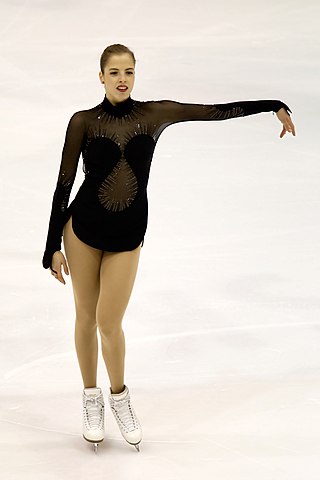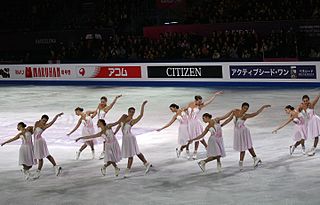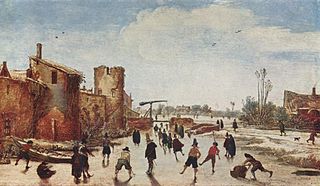 | |
| Formation | 1849/1861 |
|---|---|
| Location |
|
President | Laura Mitchell |
Skating Director | Regina Woodward Barr |
| Website | www |
The Philadelphia Skating Club and Humane Society is the oldest figure skating club in the United States. [1]
 | |
| Formation | 1849/1861 |
|---|---|
| Location |
|
President | Laura Mitchell |
Skating Director | Regina Woodward Barr |
| Website | www |
The Philadelphia Skating Club and Humane Society is the oldest figure skating club in the United States. [1]
The predecessor organization, called "The Skater's Club of the City and County of Philadelphia", was founded in 1849, and merged with the assets of the Humane Society of Philadelphia in 1861. The latter organization was patterned after the Royal Humane Society; the original purpose of the club was to patrol outdoor skating areas around the city of Philadelphia, such as the Schuylkill River, in order to rescue skaters who had fallen through the ice. Club regulations still require members to carry a reel of stout twine for lifesaving purposes while skating outdoors.
In 1921, the Philadelphia Skating Club and Humane Society was one of the seven original clubs which formed the United States Figure Skating Association. It is one of the few clubs in the United States that owns its own rink, located in Ardmore, Pennsylvania, which opened in 1938.
Today, the Philadelphia Skating Club and Humane Society retains its traditions of both on and off-ice social events and activities while offering year-round recreational and competitive figure skating.
Notable skaters who have represented the club over the years include Dick Button, Scott Hamilton, and ice dance partners Kimberly Navarro and Brent Bommentre.
PSC&HS hosts two annual competitions. Challenge Cup in September and Boots and Blades in April. Challenge Cup is a US Figure Skating National Qualifying Series event first held in 1982. It includes singles and ice dance events from No Test to Senior levels. Boots and Blades is a non-qualifying competition for skaters at the Snowplow Sam to Preliminary test levels; it also includes solo dance and showcase events. The club periodically hosts the Philadelphia Areas Figure Skating Championships (commonly known as "All-Areas") on behalf of The Association of Philadelphia Area Figure Skating Clubs.
The US Figure Skating Eastern Adult Sectional championships were held at PSC&HS in March 2020.
PSC&HS has several adult and junior synchronized skating teams that compete as Philly Spirit. The three junior teams are known as the Philly Spirit Starlets.

Figure skating is a sport in which individuals, pairs, or groups perform on figure skates on ice. It was the first winter sport to be included in the Olympic Games, when contested at the 1908 Olympics in London. The Olympic disciplines are men's singles, women's singles, pair skating, and ice dance; the four individual disciplines are also combined into a team event, first included in the Winter Olympics in 2014. The non-Olympic disciplines include synchronized skating, Theater on Ice, and four skating. From intermediate through senior-level competition, skaters generally perform two programs, which, depending on the discipline, may include spins, jumps, moves in the field, lifts, throw jumps, death spirals, and other elements or moves.

The World Figure Skating Championships ("Worlds") is an annual figure skating competition sanctioned by the International Skating Union. Medals are awarded in the categories of men's singles, women's singles, pair skating, and ice dance. Generally held in March, the World Championships are considered the most prestigious of the ISU Figure Skating Championships. With the exception of the Olympic title, a world title is considered to be the highest competitive achievement in figure skating.

Figure skates are a type of ice skate used by figure skaters. The skates consist of a boot and a blade that is attached with screws to the sole of the boot. Inexpensive sets for recreational skaters are available, but most figure skaters purchase boots and blades separately and have the blades mounted by a professional skate technician.

Synchronized skating, sometimes called synchro, is an ice skating sport where between 8 and 16 skaters perform together as a team. They move as a flowing unit at high speed over the ice, while performing elements and footwork.
Artistic roller skating is a competitive sport similar to figure skating but where competitors wear roller skates instead of ice skates. Within artistic roller skating, there are several disciplines:
U.S. Figure Skating is the national governing body for the sport of figure skating in the United States. It is recognized as such by the United States Olympic & Paralympic Committee (USOPC) under the Ted Stevens Olympic and Amateur Sports Act and is the United States member of the International Skating Union (ISU). Although the official name of the organization is "the United States Figure Skating Association," it is now known as and conducts business under the name "U.S. Figure Skating." Founded in 1921, U.S. Figure Skating regulates and governs the sport and defines and maintains the standard of skating proficiency. It specifies the rules for testing, competitions, and all other figure skating related activities. U.S. Figure Skating promotes interest and participation in the sport by assisting member clubs, skaters, and athletes, appointing officials, organizing competitions, exhibitions, and other figure skating pursuits, and offering a wide variety of programs.

Figure skating was first contested in the Olympic Games at the 1908 Summer Olympics. Since 1924, the sport has been a part of the Winter Olympic Games.

The history of figure skating stretches back to prehistoric times. Primitive ice skates appear in the archaeological record from about 3000 BC. Edges were added by the Dutch in the 13th and 14th century. International figure skating competitions began appearing in the late 19th century; in 1891, the European Championships were inaugurated in Hamburg, Germany, and in 1896, the first World Championship were held in Saint Petersburg, Russian Empire. At the 1908 Summer Olympics in London, England, figure skating became the first winter sport to be included in the Olympics.
The following is a glossary of figure skating terms, sorted alphabetically.
A figure skating club is a local organization of figure skaters, often centered on a single ice rink. Typical club activities include arranging practice ice time, hosting test sessions and competitions, and producing an annual ice show in which club skaters may take part. Some clubs also emphasize non-skating social activities.
The Skating Club of Boston is a not-for-profit figure skating club based in Norwood, Massachusetts. Founded in 1912, it is one of the oldest skating clubs in the United States, and a founding member of U.S. Figure Skating, the governing body for the sport in the United States. The Club's mission is to advance participation, education and excellence in skating for people of all ages, abilities and means. The Club has over 800 active members and offers a variety of programs for the public, reaching another 2,000 children and adults. The club built its own rink in Brighton, Massachusetts in 1938 and remained there until moving to the Norwood facility in 2020. In addition, in a public private partnership with the City of Boston's Parks & Recreation Department, the Club manages the programming and facilities for The Frog Pond located at Boston Common on a year-round basis.
A figure skating competition is a judged sports competition in figure skating.
Adult figure skating is a term used by skating organizations to refer to tests and competitions for amateur ice skaters over 21. The category was originally aimed at skaters who had taken up the sport as adults, but more recently has expanded to include adult skaters performing and competing at an 'elite' level, many of whom had skated competitively as children or adolescents. Adults who are learning to skate without prior experience are also included. In addition, a "Young Adult" category has been added to many Adult events.
The U.S. Synchronized Skating Championships is an annual synchronized skating competition, sanctioned by U.S. Figure Skating, held to determine the national champions of the United States. It was first held in 1984. Teams who qualify at a Sectional Championship competition compete in eight levels: juvenile, intermediate, novice, junior, senior, collegiate, adult and masters. The top two senior teams then go on to compete at the World Synchronized Skating Championships, while at the Junior level the teams competing at the World Junior Synchronized Skating Championships is predetermined by a Junior World Qualifier competition. The teams competing at the Junior Level at the U.S. Synchronized Skating Championships are competing for international assignment for the next years.

The Richard J. Codey Arena at South Mountain is an ice hockey and ice skating arena in West Orange, New Jersey as part of the South Mountain Recreation Complex. The arena is named for former Governor of New Jersey Richard Codey. The Codey Arena is owned and operated by the Essex County Department of Park, Recreation, and Cultural Affairs.

Maia Harumi Shibutani is an American ice dancer. Partnered with her brother Alex Shibutani, she is a two time 2018 Olympic bronze medalist, a three-time World medalist, the 2016 Four Continents champion, and a two-time U.S. national champion. The siblings have won six titles on the Grand Prix series and stood on the podium at 14 consecutive U.S. Championships, at five levels including eight as seniors. They are two-time members of the US Olympic team, competing at the 2014 and 2018 Winter Olympics. In 2018, the siblings became the first ice dancers who are both of Asian descent to medal at the Olympics. They are the second sibling duo to ever share an ice dancing Olympic medal, and the first from the United States. The Shibutani siblings are often referred to by their nickname the Shib Sibs.

The San Diego Figure Skating Club was established in 1939, received its charter from the United States Figure Skating Association and registered its Articles of Corporation on July 27, 1940 in the State of California. The Club’s purpose is to foster, promote, encourage, advance and improve the art of and interest in figure skating, and to encourage and to cultivate a spirit of harmony and friendship among ice skaters by such means as may be proposed from time to time by the membership. It is one of the oldest skating clubs in California.
The Essex Skating Club is a figure skating club based at Richard J. Codey Arena in West Orange, New Jersey. The club has teams and over 300 skaters who compete in many national competitions.

The 2015–16 Grand Prix of Figure Skating Final and ISU Junior Grand Prix Final took place from December 10 to 13, 2015 in Barcelona, Spain. Hosted by Barcelona for the second year in a row, the combined event was the culmination of two international series — the Grand Prix of Figure Skating and the Junior Grand Prix. Medals were awarded in the disciplines of men's singles, women's singles, pair skating, and ice dancing on the senior and junior levels. For the first time, medals were also awarded in synchronized skating.